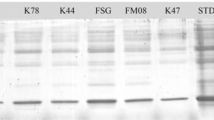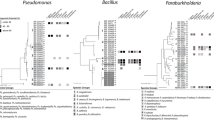Abstract
Aims
Verticillium wilt is difficult to suppress, and causes severe yield losses in a broad range of crops. Five Serratia and five Paenibacillus endophytic isolates showing antagonistic properties against fungal pathogens were compared for their plant growth-promoting (PGP) potential under different plant growth conditions with the objective of evaluating the PGP of endophytic strains in different ad planta systems.
Methods
Preselected isolates were applied to the surface-sterilized seeds of oilseed rape and cauliflower using bio-priming. The isolates’ PGP effect and root colonization capacities were compared under gnotobiotic conditions. One strain from each genus was selected and tested for its PGP qualities in sterile and non-sterile soil.
Results
Serratia treatment resulted in different levels of PGP, while Paenibacillus strains damaged roots under gnotobiotic conditions. P. polymyxa Sb3-1 did not have a significant effect on plant growth in non-sterile soil; however it did promote plant growth in the sterile soil. S. plymuthica 3RP8 and P. polymyxa Sb3-1 were selected for further testing of their biocontrol effect under field conditions.
Conclusions
The choice of growth environments in the investigation of plant-bacterium interaction is crucial. Non-sterile soil is suggested as the ideal medium for use in studying the PGP effect.


Similar content being viewed by others
References
Amman RI, Binder BJ, Olson RJ, Chisholm SW, Devereux R, Stahl DA (1990) Combination of 16S rRNA-targeted oligonucleotide probes with flow cytometry for analyzing mixed microbial populations. Appl Environ Microbiol 56:1919–1925
Anand R, Paul L, Chanway C (2006) Research on endophytic bacteria: recent advances with forest trees. In: Schulz B, Boyle C, Sieber TN (eds) Microbial Root Endophytes. Springer, Berlin, pp 89–106
Berg G (2009) Plant–microbe interactions promoting plant growth and health: perspectives for controlled use of microorganisms in agriculture. Appl Microbiol Biotechnol 84(1):11–18
Berg G, Roskot N, Steidle A, Eberl L, Zock A, Smalla K (2002) Plant-dependent genotypic and phenotypic diversity of antagonistic rhizobacteria isolated from different Verticillium host plants. Appl Environ Microbiol 68:3328–3338
Berg G, Krechel A, Ditz M, Sikora RA, Ulrich A, Hallmann J (2005) Endophytic and ectophytic potato‐associated bacterial communities differ in structure and antagonistic function against plant pathogenic fungi. FEMS Microbiol Ecol 51:215–229
Berg G, Zachow C, Müller H, Philipps J, Tilcher R (2013) Next-generation bio-products sowing the seeds of success for sustainable agriculture. Agronomy 3(4):648–656
Bragina A, Berg C, Müller H, Moser D, Berg G (2013) Insights into functional bacterial diversity and its effects on Alpine bog ecosystem functioning. Scientific reports: 3
Cabanás CGL, Schilirò E, Valverde-Corredor A, Mercado-Blanco J (2014) The biocontrol endophytic bacterium Pseudomonas fluorescens PICF7 induces systemic defense responses in aerial tissues upon colonization of olive roots. Front Microbiol 5
Cardinale M, Vieira de Castro J, Müller H, Berg G, Grube M (2008) In situ analysis of the bacterial community associated with the reindeer lichen Cladonia arbuscula reveals predominance of Alphaproteobacteria. FEMS Microbiol Ecol 66(1):63–71
Carvalhais LC, Muzzi F, Tan CH, Hsien-Choo J, Schenk PM (2013) Plant growth in Arabidopsis is assisted by compost soil-derived microbial communities. Front Plant Sci 4
Cernava T, Mueller H, Aschenbrenner IA, Grube M, Berg, G (2015) Analyzing the antagonistic potential of the lichen microbiome against pathogens by bridging metagenomic with culture studies. Front Microbiol 6:620
D’aes J, Hua GKH, De Maeyer K, Pannecoucque J, Forrez I, Ongena M, Dietrich LEP, Thomashow LS, Mavrodi DV, Höfte M (2011) Biological control of Rhizoctonia root rot on bean by phenazine-and cyclic lipopeptide-producing Pseudomonas CMR12a. Phytopathol 101(8):996–1004
Daims H, Brühl A, Amann R, Schleifer KH, Wagner M (1999) The domain-specific probe EUB338 is insufficient for the detection of all bacteria: development and evaluation of a more comprehensive probe set. Syst Appl Microbiol 22:434–444
Debode J, Declercq B, Höfte M (2005) Identification of cauliflower cultivars that differ in susceptibility to Verticillium longisporum using different inoculation methods. J Phytopathol 153(5):257–263
Dunker S, Keunecke H, Steinbach P, von Tiedemann A (2008) Impact of Verticillium longisporum on yield and morphology of winter oilseed rape (Brassica napus) in relation to systemic spread in the plant. J Phytopathol 156:698–707
Emmert EA, Handelsman J (1999) Biocontrol of plant disease: a (Gram‐) positive perspective. FEMS Microbiol Lett 171(1):1–9
Erlacher A, Cardinale M, Grosch R, Grube M, Berg G (2014) The impact of the pathogen Rhizoctonia solani and its beneficial counterpart Bacillus amyloliquefaciens on the indigenous lettuce microbiome. Front Microbiol 5
Fürnkranz M, Lukesch B, Müller H, Huss H, Grube M, Berg G (2012) Microbial diversity inside pumpkins: microhabitat-specific communities display a high antagonistic potential against phytopathogens. Microb Ecol 63:418–428
Gasser I, Cardinale M, Müller H, Heller S, Eberl L, Lindenkamp N, Kaddor C, Steinbüchel A, Berg G (2011) Analysis of the endophytic lifestyle and plant growth promotion of Burkholderia terricola ZR2-12. Plant Soil 347(1–2):125–136
Gray CD, Kinnear PR (2012) IBM SPSS statistics 19 made simple. Psychology Press
Haagensen JA, Hansen SK, Johansen T, Molin S (2002) In situ detection of horizontal transfer of mobile genetic elements. FEMS Microbiol Ecol 42:261–268
Handelsman J, Stabb E (1996) Biocontrol of soilborne plant pathogens. Plant Cell 8(10):1855–1869
Heale JB, Karapapa VK (1999) The Verticillium threat to Canada’s major oilseed crop: Canola. Can J Plant Pathol 21(1):1–7
Jiménez-Gasco M, Malcolm GM, Berbegal M, Armengol J, Jiménez-Díaz RM (2014) Complex molecular relationship between vegetative compatibility groups (VCGs) in Verticillium dahliae: VCGs do not always align with clonal lineages. Phytopathol 104:650–9
Kalbe C, Marten P, Berg G (1996) Members of the genus Serratia as beneficial rhizobacteria of oilseed rape. Microbiol Res 151:4433–4400
Karapapa VK, Bainbridge BW, Heale JB (1997) Morphological and molecular characterization of Verticillium longisporum comb. nov. pathogenic to oilseed rape. Mycol Res 101(11):1281–1294
Kloepper JW, Schroth KJW (1980) Plant growth-promoting rhizobacteria and plant growth under gnotobiotic conditions. Phytopathol 71:642–644
Köberl M, Ramadan EM, Adam M, Cardinale M, Hallmann J, Heuer H, Smalla K, Berg G (2013) Bacillus and Streptomyces were selected as broad-spectrum antagonists against soilborne pathogens from arid areas in Egypt. FEMS Microbiol Lett 342:168–178
Kurze S, Dahl R, Bahl H, Berg G (2001) Biological control of fungal strawberry diseases by Serratia plymuthica HRO-C48. Plant Dis 85:529–534
Lal S, Tabacchioni S (2009) Ecology and biotechnological potential of Paenibacillus polymyxa: a minireview. Indian J Microbiol 49:2–10
Li J, Zhao GZ, Varma A, Qin S, Xiong Z, Huang HY, Zhu WY, Zhao LX, Xu LH, Li WJ (2012) An endophytic Pseudonocardia species induces the production of artemisinin in Artemisia. annua. PLoS One 7(12):e51410
Liebminger S, Aichner M, Oberauner L, Fürnkranz M, Cardinale M, Berg G (2011) A new textile-based approach to assess the antimicrobial activity of volatiles. Text Res J. doi:10.1177/0040517511429607
Ludwig-Müller J (2014) Auxin homeostasis, signaling and interaction with other growth hormones during the clubroot disease of Brassicaceae. Plant Signal Behav 9, e28593
Meier H, Amann R, Ludwig W, Schleifer KH (1999) Specific oligonucleotide probes for in situ detection of a major group of gram-positive bacteria with low DNA G+ C content. Syst Appl Microbiol 22(2):186–196
Messner R, Schweigrofler W, Ibl M, Berg G, Prillinger H (1996) Molecular characterization of the plant pathogen Verticillium dahliae Kleb. using RAPD-PCR and sequencing of the 18S rRNA-gene. J Phytopathol 144:347–354
Müller H, Berg G (2008) Impact of formulation procedures on the effect of the biocontrol agent Serratia plymuthica HRO-C48 on Verticillium wilt in oilseed rape. BioControl 53:905–916
Petersen LM, Tisa LS (2013) Friend or foe? A review of the mechanisms that drive Serratia towards diverse lifestyles. Can J Microbiol 59(9):627–640
Phi QT, Park YM, Seul KJ, Ryu CM, Park SH, Kim JG, Ghim SY (2010) Assessment of root-associated Paenibacillus polymyxa groups on growth promotion and induced systemic resistance in pepper. J Microbiol Biotechnol 20(12):1605–1613
Prieto P, Navarro-Raya C, Valverde-Corredor A, Amyotte SG, Dobinson KF, Mercado-Blanco J (2009) Colonization process of olive tissues by Verticillium dahliae and its in planta interaction with the biocontrol root endophyte Pseudomonas fluorescens PICF7. Microb Biotechnol 2(4):499–511
Raza W, Yang W, Shen QR (2008) Paenibacillus polymyxa: antibiotics, hydrolytic enzymes and hazard assessment. J Plant Pathol 90:419–430
Rybakova D, Cernava T, Köberl M, Liebminger S, Etemadi M, Berg G (2015) Endophytes-assisted biocontrol: novel insights in ecology and the mode of action of Paenibacillus. Plant and soil; accepted
Siebold M, Tiedemann AV (2012) Potential effects of global warming on oilseed rape pathogens in Northern Germany. Fungal Ecol 5(1):62–72
Timmusk S (2015) Sfp-type PPTase inactivation promotes bacterial biofilm formation and ability to enhance wheat drought tolerance. Front Microbiol 6:387
Timmusk S, Wagner EGH (1999) The plant-growth-promoting rhizobacterium Paenibacillus polymyxa induces changes in Arabidopsis thaliana gene expression: a possible connection between biotic and abiotic stress responses. Mol Plant Microbe 12(11):951–959
Timmusk S, Grantcharova N, Wagner EGH (2005) Paenibacillus polymyxa invades plant roots and forms biofilms. Appl Environ Microbiol 71(11):7292–7300
Tyvaert L, França SC, Debode J, Höfte M (2014) The endophyte Verticillium Vt305 protects cauliflower against Verticillium wilt. J Appl Microbiol 116(6):1563–71
Weller DM (1988) Biological control of soilborne plant pathogens in the rhizosphere with bacteria. Annu Rev Phytopathol 26:379–407
Zachow C, Fatehi J, Cardinale M, Tilcher R, Berg G (2010) Strain‐specific colonization pattern of Rhizoctonia antagonists in the root system of sugar beet. FEMS Microbiol Ecol 74(1):124–135
Zachow C, Müller H, Tilcher R, Donat C, Berg G (2013) Catch the best: novel screening strategy to select stress protecting agents for crop plants. Agronomy 3:794–815
Zeise K, Steinbach P (2004) Schwarze Rapswurzeln und der Vormarsch der Verticillium-Rapswelke. Raps 22:170–174
Zhou L, Hu Q, Johansson A, Dixelius C (2006) Verticillium longisporum and V. dahliae: infection and disease in Brassica napus. Plant Pathol 55(1):137–144
Acknowledgments
The authors would like to thank Timothy Mark (Graz) for English revision and discussion. This project was funded by the European Union in frame of FP7-KBBE-2013-7-single-stage (BIOCOMES; No. 612713) and by the Austrian Research Promotion Agency (FFG; No. 836466). The authors gratefully acknowledge support from NAWI Graz. We thank Christin Zachow (Graz) for her help regarding experimental questions and Anastasia Bragina (Graz) for help regarding statistical issues.
Author information
Authors and Affiliations
Corresponding author
Additional information
Responsible Editor: Birgit Mitter.
Rights and permissions
About this article
Cite this article
Rybakova, D., Schmuck, M., Wetzlinger, U. et al. Kill or cure? The interaction between endophytic Paenibacillus and Serratia strains and the host plant is shaped by plant growth conditions. Plant Soil 405, 65–79 (2016). https://doi.org/10.1007/s11104-015-2572-8
Received:
Accepted:
Published:
Issue Date:
DOI: https://doi.org/10.1007/s11104-015-2572-8




